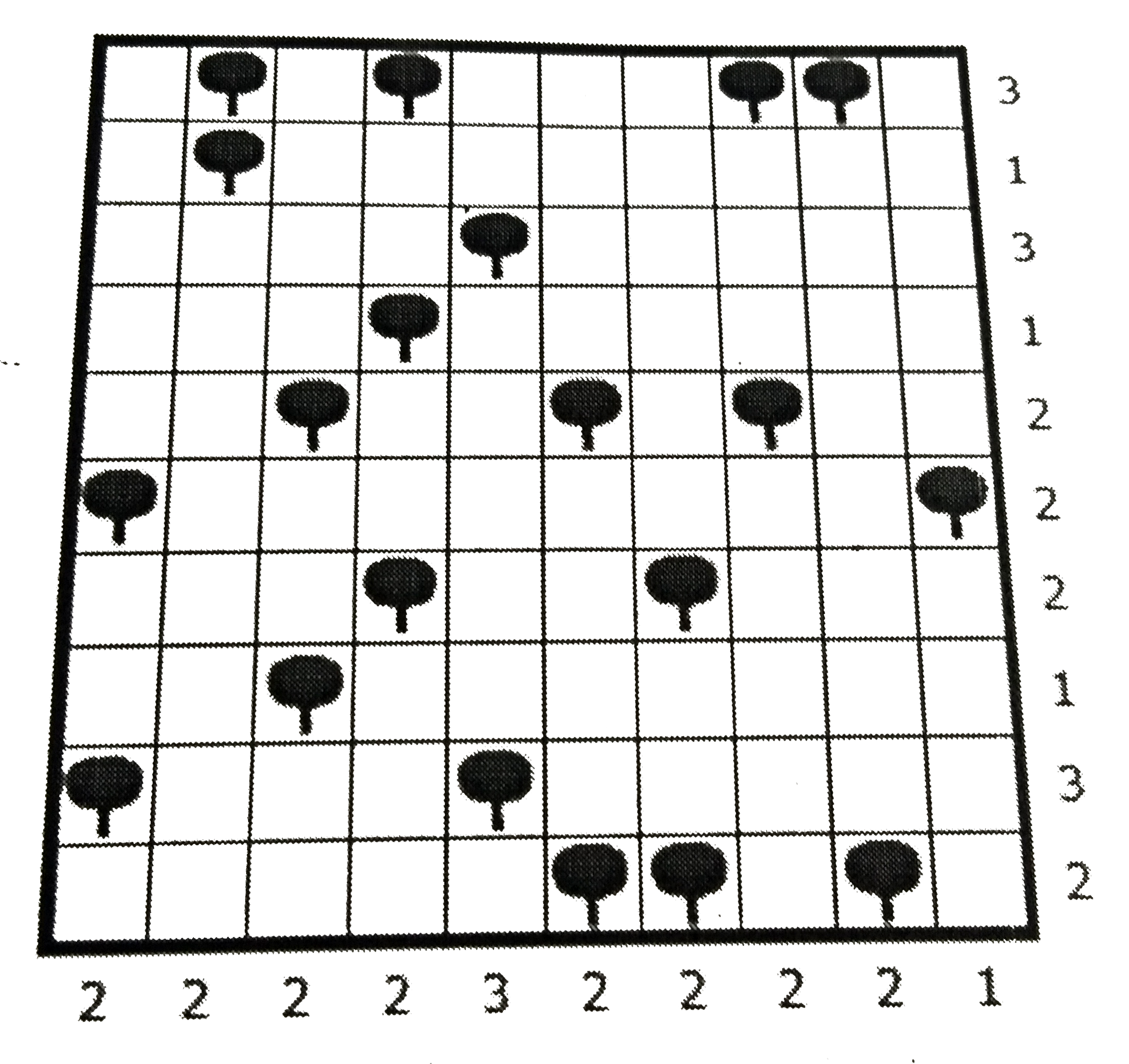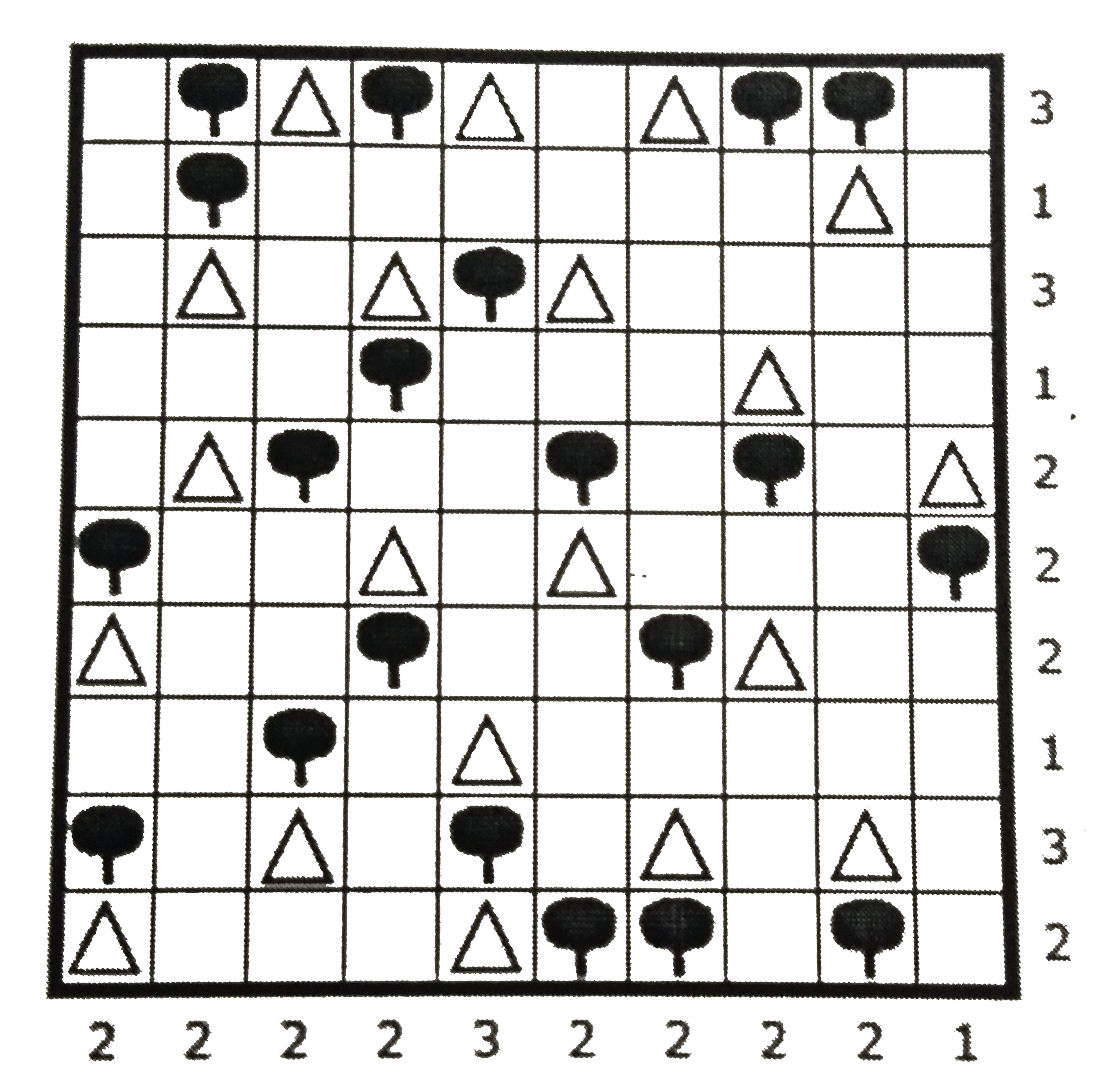Attach a tent to each tree, in a horizontally or vertically adjacent cell. Cells with tents do not touch each other, not even diagonally. Numbers outside the grid indicate the number of tents in that row or column.The numbering of odd, even squares starts from the bottom left corner. Odd rows are given the value of 1, and even rows are given the value of 2. Similarly, odd columns are given a value of 1, and even columns are given a value of two. The value of a cell is the product of its row value and column value. What is the sum of values of all cells that have a tent in it?
Now having figured out the tent arrangement, the trainer happily teaches Max’s Bulbasaur a new move, Cut. Now armed with the new move, Max makes his way to the Vermillon City gym after clearing the tree in front of it using his new move. He now faces Lt. Surge and his army of Electric pokémon. Despite not having an outright advantage, Max battles it out and manages to earn his Thunder Badge.

39
32
47
43
Similar Questions
In each of the following questions, two rows of numbers are given. The resultant number in each row is to be worked out separately based on the following rules and the questions below the rows of numbers are to be answered. The operations of numbers progress from the left to the right. Rules: (i) If an odd number is followed by another composite odd number, they are to be multiplied (ii) If an even number is followed by an odd number, they are to be added. (iii) If an even number is followed by a number which is the perfect square, the even number is to be subtracted from the perfect square. (iv) If an odd number is followed by an even number, the first number is to be subtracted from the first one. (v) If an odd number is followed by an prime odd number, the first number is to be divided by the second number. 35 7 2 12 16 x If x is the resultant of the first row, what will be the answer if the resultant of the two rows are multiplied ? 1) 7 2) 10 3) 24 4) 21 5)None of these
View SolutionIn each of the following questions, two rows of numbers are given. The resultant number in each row is to be worked out separately based on the following rules and the questions below the rows of numbers are to be answered. The operations of numbers progress from the left to the right. Rules: (i) If an odd number is followed by another composite odd number(a non-prime number), they are to be multiplied (ii) If an even number is followed by an odd number, which is not a perfect square, they are to be added. (iii) If an even number is followed by a number which is the perfect square, the even number is to be subtracted from the perfect square. (iv) If an odd number is followed by a prime odd number, the first number is to be divided by the second number. (v) If an odd number is followed by an even number, the second one is to be subtracted from the first one. 6 9 15 x 12 11 If x is the resultant of the first row, what is the resultant of the second row ? 1) 33 2) 45 3) 11 4) 15 5) 3
View SolutionIn each of the following questions, two rows of numbers are given. The resultant number in each row is to be worked out separately based on the following rules and the questions below the rows of numbers are to be answered. The operations of numbers progress from the left to the right.
Rules:
(i) If an odd number is followed by another composite odd number(a non-prime number), they are to be multiplied
(ii) If an even number is followed by an odd number, which is not a perfect square, they are to be added.
(iii) If an even number is followed by a number which is the perfect square, the even number is to be subtracted from the perfect square.
(iv) If an odd number is followed by a prime odd number, the first number is to be divided by the second number.
(v) If an odd number is followed by an even number, the second one is to be subtracted from the first one.
18 37 5
2 m 6
If m is the resultant of the first row, what is the resultant of the second row ?
1) 19
2) 55
3) 78
4) 7
9
View SolutionIn each of the following questions, two rows of numbers are given. The resultant number in each row is to be worked out separately based on the following rules and the questions below the rows of numbers are to be answered. The operations of numbers progress from the left to the right.
Rules:
(i) If an odd number is followed by another composite odd number(a non-prime number), they are to be multiplied
(ii) If an even number is followed by an odd number, which is not a perfect square, they are to be added.
(iii) If an even number is followed by a number which is the perfect square, the even number is to be subtracted from the perfect square.
(iv) If an odd number is followed by a prime odd number, the first number is to be divided by the second number.
(v) If an odd number is followed by an even number, the second one is to be subtracted from the first one.
27 12 3
p 9 5
If p is the resultant of the first row, what is the resultant of the second row ?
1) 50
2) 9
3) 40
4) 5
5)8
View SolutionIn each of the following questions two row numbers are given. The resultant number in each row is to be worked out separately based on the following rules and the question below the rows is to be answered. The operations of numbers progress from left to right.
Rules.
(i) If an even number is followed by another even number they are to be added.
(ii) If an even number is followed by a prime number, they are to be multiplied.
(iii) If an odd number is followed by an even number, the even number is to be subtracted from the odd number.
(iv) If an odd number is followed by another odd number, first number is to be added to the square of the second number.
(v) If an even number is followed by a composite odd number, the even number is to be divided by the odd E number.
I.842113II.151144
What is half of the sum of the resultant of the two row ?
View SolutionIn each of the following questions two row numbers are given. The resultant number in each row is to be worked out separately based on the following rules and the question below the rows is to be answered. The operations of numbers progress from left to right.
Rules.
(i) If an even number is followed by another even number they are to be added.
(ii) If an even number is followed by a prime number, they are to be multiplied.
(iii) If an odd number is followed by an even number, the even number is to be subtracted from the odd number.
(iv) If an odd number is followed by another odd number, first number is to be added to the square of the second number.
(v) If an even number is followed by a composite odd number, the even number is to be divided by the odd E number.
I.12716II.792815
What is the difference between the resultant of the second row and the first row ?
View SolutionIn each of the following questions two row numbers are given. The resultant number in each row is to be worked out separately based on the following rules and the question below the rows is to be answered. The operations of numbers progress from left to right.
Rules.
(i) If an even number is followed by another even number they are to be added.
(ii) If an even number is followed by a prime number, they are to be multiplied.
(iii) If an odd number is followed by an even number, the even number is to be subtracted from the odd number.
(iv) If an odd number is followed by another odd number, first number is to be added to the square of the second number.
(v) If an even number is followed by a composite odd number, the even number is to be divided by the odd E number.
I.361339II.77307
What will the outcome if the resultant of the second row is divided by the resultant of the first row ?
View SolutionIn each of the following question two row numbers are given. The resultant number in each row is to be worked out separately based on the following rules and the question below the rows is to be answered. The operations of numbers progress from left to right.
Rules.
(i) If an odd number is followed by another odd number, they are to be multiplied.
(ii) If an even number is followed by another even number, the first number is to be divided by the second even number.
(iii) If an even number is followed by the perfect square of an odd number the first number is to be subtracted from the second number.
(iv) If an odd number is followed by an even number, the two are to be added.
(v) If an even number is followed by an odd number, which is not a perfect square, the square of the odd number is to be added to the even number.
961681=x111518=y
What is the value of y - 2x ?
View Solution

